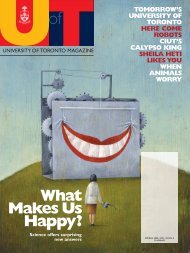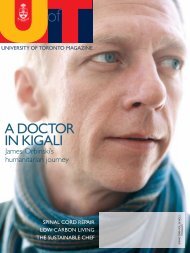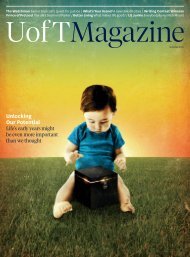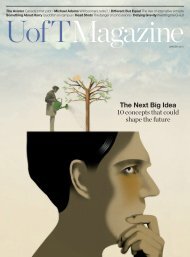What's the solution to Toronto's traffic problems? - University of ...
What's the solution to Toronto's traffic problems? - University of ...
What's the solution to Toronto's traffic problems? - University of ...
You also want an ePaper? Increase the reach of your titles
YUMPU automatically turns print PDFs into web optimized ePapers that Google loves.
Improbably, ano<strong>the</strong>r group <strong>of</strong> women launched a women’s<br />
studies course at U <strong>of</strong> T in 1971 – one that was even more<br />
contentious. Ceta Ramkhalawansingh was only a second-year<br />
undergrad representative on <strong>the</strong> Interdisciplinary Studies<br />
committee when a women’s course was proposed in 1970. Yet<br />
she and graduate student Kay Armatage ran with <strong>the</strong> suggestion,<br />
organizing a teaching collective composed <strong>of</strong> some 15<br />
students and women from <strong>the</strong> movement. They met weekly<br />
over <strong>the</strong> summer <strong>to</strong> develop<br />
a syllabus. “We proposed<br />
texts from our various<br />
disciplines, read intensely<br />
and became one ano<strong>the</strong>r’s<br />
teachers,” says Ramkhalawansingh.<br />
In addition <strong>to</strong><br />
making <strong>the</strong> course interdisciplinary<br />
and cross-cultural,<br />
<strong>the</strong>y were determined <strong>to</strong><br />
break down <strong>the</strong> traditional<br />
teacher/student hierarchical<br />
structure. Ra<strong>the</strong>r than<br />
formal lectures, <strong>the</strong>re<br />
would be student-led<br />
discus sions. They wanted<br />
students <strong>to</strong> question what<br />
and how <strong>the</strong>y were taught<br />
and evaluated. The head <strong>of</strong><br />
Interdisciplinary Studies,<br />
Pr<strong>of</strong>essor Ge<strong>of</strong>frey Payzant,<br />
was supportive, but could<br />
not approve <strong>the</strong> course until<br />
a faculty member joined<br />
<strong>the</strong> teaching collective. (He<br />
taught philosophy.) It was<br />
no easy task given <strong>the</strong>re<br />
were so few female pr<strong>of</strong>essors and fewer still in a position<br />
<strong>to</strong> risk careers on such a radical venture. They finally found<br />
an ally in Pr<strong>of</strong>essor Barbara Martineau at Scarborough<br />
College, and “FSW 200: Women in <strong>the</strong> Twentieth Century”<br />
was launched.<br />
Some 200 women and a few men signed up. They were<br />
taught in seminars <strong>of</strong> 20 people each by teams <strong>of</strong> two from<br />
<strong>the</strong> teaching collective – which was composed <strong>of</strong> graduate<br />
students, women from <strong>the</strong> movement who weren’t even<br />
students at U <strong>of</strong> T and Ramkhalawansingh, though she was just<br />
in her third year. Their ambition <strong>to</strong> foster change was huge.<br />
“Our focus was shining a light on inequality,” she says. “Our<br />
approach was very experimental. We were thumbing our<br />
nose a bit at <strong>the</strong> university.” The collective also ran a weekly<br />
lecture series that was open <strong>to</strong> <strong>the</strong> public, drawing some 300<br />
<strong>to</strong> 500 people <strong>to</strong> hear noted feminists such as journalist June<br />
Callwood, writer Margaret Atwood (BA 1961 Vic<strong>to</strong>ria), and<br />
lawyer and now Supreme Court judge Rosalie Abella (BA 1967<br />
<strong>University</strong> College).<br />
Writer Myrna Kostash (MA 1968) wrote a detailed diary-style<br />
account <strong>of</strong> that first year in women’s studies for Miss Chatelaine<br />
magazine (<strong>to</strong> read <strong>the</strong> article, visit magazine.u<strong>to</strong>ron<strong>to</strong>.ca).<br />
While <strong>the</strong> collective designed <strong>the</strong> course <strong>to</strong> be scholarly<br />
and substantive, <strong>the</strong>y intended it <strong>to</strong> be personal and political,<br />
and invited students <strong>to</strong> relate <strong>the</strong>ir own experiences <strong>to</strong> <strong>the</strong><br />
material. “It was a new way <strong>of</strong> getting people <strong>to</strong> learn,” wrote<br />
Kostash. While students eagerly attended class, it wasn’t until<br />
nearly halfway through<br />
that many dared speak up.<br />
Noted Kostash: “The Women’s<br />
Course is probably <strong>the</strong><br />
most vital thing we could<br />
do at university and all we<br />
do is listen politely and<br />
nod about how oppressed<br />
we all are.” But, she wrote<br />
that when <strong>the</strong> floodgates<br />
finally opened, discussions<br />
turned in<strong>to</strong> near “screaming<br />
matches” as women<br />
uncovered <strong>the</strong>ir own “shitty<br />
attitudes” <strong>to</strong>ward o<strong>the</strong>r<br />
women and began questioning<br />
everything – how <strong>the</strong>y<br />
had been socialized <strong>to</strong><br />
think and behave according<br />
<strong>to</strong> patriarchal norms<br />
and even accept <strong>the</strong>ir own<br />
oppression.<br />
The next year, <strong>the</strong> teaching<br />
collective cheekily<br />
pushed <strong>the</strong> university <strong>to</strong><br />
establish a women’s studies<br />
program by producing<br />
an un<strong>of</strong>ficial calendar, highlighting existing courses<br />
that might complement such a program as well as sexist<br />
terms from <strong>of</strong>ficial university documents. They cut,<br />
pasted, pho<strong>to</strong>copied and distributed <strong>the</strong> “brochure”<br />
around campus, bringing considerable embarrassment<br />
<strong>to</strong> <strong>the</strong> administration. “We were <strong>to</strong>ld that this was not<br />
<strong>the</strong> way things were done,” says Ramkhalawansingh, “that<br />
a committee must be struck <strong>to</strong> look at <strong>the</strong> question.” A<br />
committee was struck, and it recommended a women’s<br />
studies program, which was <strong>of</strong>ficially launched in 1974/75 with<br />
a minor. Major and specialist degrees were added in 1980/81.<br />
Ramkhalawansingh taught in <strong>the</strong> program while she did<br />
graduate work <strong>the</strong>n joined <strong>the</strong> City <strong>of</strong> Toron<strong>to</strong> <strong>to</strong> develop<br />
its equity and diversity programs. She also helped establish<br />
City <strong>of</strong> Toron<strong>to</strong> scholarships for U <strong>of</strong> T’s women’s studies<br />
program. Armatage stayed at <strong>the</strong> university <strong>to</strong> help build <strong>the</strong><br />
program, a monumental challenge given she and many <strong>of</strong><br />
her colleagues did not have tenure in those early years, and<br />
<strong>the</strong> program had no departmental status <strong>to</strong> appoint faculty.<br />
summer 2012 35

















